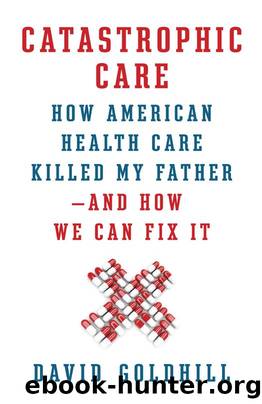Catastrophic Care: How American Health Care Killed My Father--and How We Can Fix It by David Goldhill

Author:David Goldhill [Goldhill, David]
Language: eng
Format: azw3
ISBN: 9780307961556
Publisher: Knopf Doubleday Publishing Group
Published: 2013-01-07T16:00:00+00:00
* John Goodman, “Three Simple Ways Medicare Can Save Money,” Wall Street Journal, August 11, 2011.
† A Health Affairs blog post shows this differential in action. Medicare rates are $836 for a routine cataract removal, which takes ten to fifteen minutes, but only $111 for a primary care visit, which can last twenty-five minutes and include a broad variety of diagnostic and treatment complications (John Goodman, “Three Simple Ways Medicare Can Make Money,” Wall Street Journal, August 11, 2011).
‡ Precise numbers are hard to obtain, but MedPAC data suggest that on average Medicare pays 88 percent of what commercial insurers pay, with Medicaid paying between 66 and 72 percent of Medicare rates (www.statehealthfacts.org/comparetable.jsp?ind=196&cat=4). A 2005 Michigan State Medical Society survey reported that for a diagnostic colonoscopy, Blue Cross reimbursed $209, Medicare $175, and Medicaid $91. For an appendectomy, the numbers were $784, $676, and $336 (Vanessa Fuhrmans, “Note to Medicaid Patients: The Doctor Won’t See You,” Wall Street Journal, July 19, 2007).
§ Some experts believe this is a social good—that those fortunate enough to have private insurance should subsidize those on Medicare and Medicaid by paying more through cost shifting.
‖ A recent Kaiser study suggests that insurers will have to pay almost $1.3 billion in rebates on individual policies in the first year of the ACA. “This alone is not going to make health insurance affordable for large numbers of people, but it is getting excess administrative cost out of the system,” the study claimed (Julie Appleby, “Checks in the Mail,” Kaiser Health News, April 26, 2012). I doubt it. More likely is that the rebate possibility will offer insurers future cover for higher premiums (something like: “If these premiums turn out to be too high, don’t worry: you’ll get a year-end rebate in that case”).
a Some advocates of the MLR rules contend that insurance profits are too high, and that the rule will discipline excess profits. But this is typical static analysis. Over time insurers measure profits as return on equity, like all other big companies. So if margin declines are not associated with premiums increases (as in the hypothetical El Diablo example above), we would expect capital to exit the health insurance business. This would make the business even less competitive, and in a dynamic world, such a development is rarely associated with profit declines.
b One ironic consequence of the MLR rule is that it implicitly acknowledges that health insurers aren’t really in the insurance business. All types of insurance are subject to strict regulations that cap the maximum amount an insurer can pay in claims, not that specify a minimum amount, as the MLR rule does. Why? In real insurance, the regulator is concerned that an insurance company is paying out too much in claims to attract business and that too high a payout leaves too little in reserves and profits to ensure its ability to meet future claims. Insurance regulation has always been primarily concerned with the safety and financial soundness of insurers. The MLR rule
Download
This site does not store any files on its server. We only index and link to content provided by other sites. Please contact the content providers to delete copyright contents if any and email us, we'll remove relevant links or contents immediately.
| Administration & Medicine Economics | Allied Health Professions |
| Basic Sciences | Dentistry |
| History | Medical Informatics |
| Medicine | Nursing |
| Pharmacology | Psychology |
| Research | Veterinary Medicine |
Machine Learning at Scale with H2O by Gregory Keys | David Whiting(4200)
Fairy Tale by Stephen King(3229)
Will by Will Smith(2797)
Hooked: A Dark, Contemporary Romance (Never After Series) by Emily McIntire(2502)
Rationality by Steven Pinker(2295)
Friends, Lovers, and the Big Terrible Thing by Matthew Perry(2126)
The Becoming by Nora Roberts(2095)
Love on the Brain by Ali Hazelwood(1967)
HBR's 10 Must Reads 2022 by Harvard Business Review(1782)
The Strength In Our Scars by Bianca Sparacino(1778)
A Short History of War by Jeremy Black(1764)
Leviathan Falls (The Expanse Book 9) by James S. A. Corey(1651)
515945210 by Unknown(1603)
A Game of Thrones (The Illustrated Edition) by George R. R. Martin(1596)
Bewilderment by Richard Powers(1541)
443319537 by Unknown(1473)
The 1619 Project by Unknown(1389)
The Real Anthony Fauci: Bill Gates, Big Pharma, and the Global War on Democracy and Public Health (Childrenâs Health Defense) by Robert F. Kennedy(1368)
Fear No Evil by James Patterson(1282)
